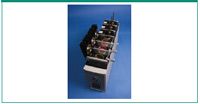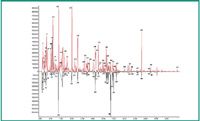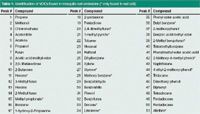Determining the Health Impact of Burning Mosquito Coils Using Versatile Micro-chamber Sampling and TD-GC-MS
The Application Notebook
Burning mosquito coils is common in many countries, however, the emission of various, potentially toxic volatile organic compounds (VOCs) is cause for concern. Novel sampling equipment with TD-GC-MS is used to extract, concentrate and analyse the emissions of two burning coils and determine any potential impact on consumer health.
Lara Kelly, Markes International Ltd, Llantrisant, Rhondda Cynon Taff, UK.
Introduction
Mosquito coils are a form of incense whose active ingredients are usually derived from pyrethin, a natural insecticide. When burnt, the smoke repels, paralyses or kills mosquitoes. These coils are very popular in Asia, Africa and South America; however, there has been concern about levels and potential harm of chemicals emitted, for example, polycyclic aromatic hydrocarbons (PAHs) or aldehydes [types of volatile organic compounds (VOCs) with known health effects], particularly when burned for long periods in confined or poorly ventilated areas.1 Two types of coil (one red, one black) were obtained and burnt, and their VOC emissions compared to estimate their safety.
To analyse the emissions of a particular substance, novel microscale chamber equipment provides a compact, portable unit that allows fast screening of several samples, simultaneously (Figure 1).2 For bulk emissions testing, a small amount of a sample is placed in the bottom of an individual chamber pot. Several pots can then be inserted into the micro-chamber unit set to a prescribed temperature. Emitted vapour is extracted and retained using sorbent tubes, and its VOC composition determined by GC(–MS). To obtain a comprehensive representation of the VOC emissions, thermal desorption of the extracted vapours was performed prior to GC–MS analysis. This well-established technique concentrates the VOCs from a large sample into a narrow band of vapour and efficiently injects this directly into the GC column, giving results with far higher sensitivity, therefore, allowing more reliable compound identification.

Figure 1: A micro-chamber sampling unit with six chambers.
Experimental Conditions
Sections (~40 mm) of both red and black mosquito coils were cut and lit. These were then placed inside individual micro-chamber pots (constructed from inert-coated stainless steel), which were inserted into the micro-chamber sampling unit and sealed. The samples were left to equilibrate for 10 min under a constant flow of dry air (to ensure lit samples were not extinguished). A conditioned TD tube containing a combination of sorbents (allowing the retention of a broad range of analytes) was placed on the outlet port of each of the chambers, with a diffusion locking cap (Markes International Ltd, UK) on the non-sampling end to allow air flow and prevent contaminant ingress. The tubes were removed after 30 minutes.
Following sampling, the tubes were placed onto the TD system, desorbed and then analysed by GC–MS. Full conditions are listed below.
Instrument Conditions
Micro-chamber sampling:
Instrument: Micro-Chamber/Thermal Extractor (Markes International Ltd)
TD tube sorbents: Tenax TA (Buchem BV, The Netherlands) and UniCarb (Markes International)
Carrier gas: Dry air
Flow rate: 50 mL/min
Temperature: 40 ºC
Thermal desorption:
Instrument: UNITY 2 (Markes International)
Flow path: 200 ºC
Trap purge time: 1 min
Primary desorption: 10 min, 300 ºC
Trap conditions: −10 ºC, 300 ºC, hold 5 min
Trap type: Sulphur trap (Markes International)
GC–MS:
Instrument: Agilent 7890/5975
Column: Ultra 2.5% PMS, 50 m, 0.32 µm, 0.52 µm
Column flow: 1.8 mL/min, constant flow
Temperature programme: 50 ºC (2 min), ramp at 25 ºC/min to 160 ºC, then ramp at 10 ºC/min to 280 ºC, hold for 30 min
Carrier gas: He
Mass scan range: 35–300
The GC–MS data file produced was imported into TargetView (ALMSCO International, UK) software to deconvolute the data and identify compounds automatically.3
Results and Discussion
Figure 2 displays the VOC profiles of both the red and the black mosquito coils when burning. The complexity of the chromatograms gives an indication to the high chemical emissions and the efficiency of the extraction/concentration technique used. The differences between the two mosquito coils are visible; although there are many common compounds, these are often present in different abundances. TargetView, a deconvolution and identification software package, was used to automatically and quickly determine the identity of peaks in the complex data with high confidence (a match co-efficient exclusion value of > 0.7 was used); these are listed in Table 1. Compounds that are present in the red mosquito coil only are marked with an asterisk.

Figure 2: Chromatograms of VOCs from red mosquito coil (upper) and black mosquito coil (lower; inverted).
Some of the compounds found were non-toxic fragrance compounds. However, of concern, the most abundant compound emitted from the red coil, and a significant contributor to emissions of the black coil, is benzene, a known carcinogen and one linked to many serious health problems. The chromatograms also show that many other suspected carcinogens, for example, furan, ethylbenzene and naphthalene (which are categorized as IARC Group 2B carcinogens), or respiratory tract irritants, for example, benzaldehyde, tridecane and phenol, are observed in both but are more abundant in the red coil emissions. It is also interesting to note that allethrin, a synthetic pyrethroid (natural insecticide), is found only in the red coil emissions. In addition, the compound 2,3-butanedione, which is another mosquito repellent, is found at a significantly higher concentration in the red coil than the black.

Table 1: Identification of VOCs found in mosquito coil emissions (* only found in red coil).
Conclusion
The introduction of micro-chamber sampling technology has made in-house screening of product emissions far more accessible to manufacturers due to its simplicity, size and speed.
Via this simple yet efficient method of chemical extraction and sample concentration for GC–MS, comprehensive VOC profiles of both mosquito coils were obtained. The results suggest that though the red coil has significantly higher VOC emission levels, either coil would give cause for concern if burned for a prolonged duration in a poorly ventilated area.
References
1. W. Liu et al., Environmental Health Perspectives, 111(12), 1454–1460 (2003).
2. Markes International TDTS 67: Introducing the Micro-Chamber/Thermal Extractor (µ-CTE) for rapid screening of chemicals released (emitted) by products and materials.
3. Markes International TDTS 90: Automatic detection of trace target compounds in complex chemical emission profiles.

Markes International Ltd
Gwaun Elai Medi Science Campus, Llantrisant CF72 8XL, UK
tel. +44 1443 230935 fax +44 1443 231531
E-mail: lkelly@markes.com
Website: www.markes.com

Polysorbate Quantification and Degradation Analysis via LC and Charged Aerosol Detection
April 9th 2025Scientists from ThermoFisher Scientific published a review article in the Journal of Chromatography A that provided an overview of HPLC analysis using charged aerosol detection can help with polysorbate quantification.
Analyzing Vitamin K1 Levels in Vegetables Eaten by Warfarin Patients Using HPLC UV–vis
April 9th 2025Research conducted by the Universitas Padjadjaran (Sumedang, Indonesia) focused on the measurement of vitamin K1 in various vegetables (specifically lettuce, cabbage, napa cabbage, and spinach) that were ingested by patients using warfarin. High performance liquid chromatography (HPLC) equipped with an ultraviolet detector set at 245 nm was used as the analytical technique.
Removing Double-Stranded RNA Impurities Using Chromatography
April 8th 2025Researchers from Agency for Science, Technology and Research in Singapore recently published a review article exploring how chromatography can be used to remove double-stranded RNA impurities during mRNA therapeutics production.




















